As with any fundraising event you’re planning, hosting a walkathon, bikeathon, runathon, or any type of similar experience will take some planning, preparation, and yes—some perspiration!
A walkathon is a popular type of peer-to-peer fundraising event. To walk a walkathon, participants or teams register to walk a predetermined distance or course and secure donations and pledges from their friends, families, and acquaintances to raise money for the organization hosting the event. Bikeathons and runathons work the same way as a walkathon, but participants bike or run the course instead of walking.
Hosting an “athon” can benefit both the organization and the participants. “Athon” events can be fairly affordable, easy to plan, and increase engagement for the nonprofit. For participants, “athons” encourage healthy habits, build a sense of community, and are a fun way to help a cause they care about.
Any cause can use a walkathon. From schools to animal rights charities to medical associations, every organization can host a walkathon event and can even theme the “athon” for a specific cause or event. For example, your organization could arrange a “Pet Walkathon” and have participants bring their pets for the course, a “Halloween Runathon” where everyone runs in costume, or a “Breast Cancer Awareness Bikeathon” with participants wearing pink during the event.
Putting together an “-athon” fundraising event is no walk in the park. With new tools and digital solutions, what are the best ways to engage and motivate your participants? With the rising popularity of virtual fundraising events, you can even pivot your “-athon” event to take place entirely online!
Whether in-person or virtual, your walkathon, bikeathon, or runathon can be conquered with the help of great planning and a dedicated fundraising and event toolkit. With this step-by-step guide, planning your event should be as intuitive as hopping back on a bike!
Take a quick peek at the steps for hosting a walkathon, bikeathon, or runathon fundraiser:
- Assemble a leadership team for your fundraising event
- Select a date, time, and location
- Secure sponsorships
- File necessary event paperwork
- Create event registration and donation forms
- Design t-shirts for your event participants
- Spread the word about your fundraiser
- Have volunteers show up early
- Walk, bike, run, and have a great time!
- Thank your participants

Step 1: Assemble a leadership team for your fundraising event
Whether it’s a walkathon, bikeathon, charity auction, benefit concert, or any other fundraising event, assembling a leadership team is among the first steps of planning a fundraising event.
What is a leadership team?
To put it simply, a leadership team consists of the people who do the bulk of the behind-the-scenes work with the help of volunteers.
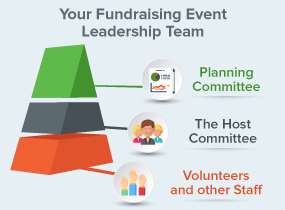
For most events, there are three levels of leadership:
- The Planning Committee
- The Host Committee
- Volunteers and Other Staff
The fundraising event planning committee
At the top of the pyramid will be your planning committee. These are the folks that are in charge of getting everything off the ground.
They’ll decide and organize aspects of the walkathon, runathon, or bikeathon, such as:
- When and where you’ll host it
- Whether it will be in-person or virtual
- Whether there will be a theme
- Who will be sponsoring it
- What the budget will be
- What the goal is
- And whom to invite
Once the initial details are in place, the planning committee will pass their baton to the host committee.
The host committee
The Host Committee will be a mix of dedicated volunteers, board members, and staff members. Once the host committee has the torch, they should hit the ground running.
They’ll be in charge of:
- Handling fundraising for the event
- Seeking donors
- Talking with participants
- And encouraging their personal and professional networks’ involvement
On the day of the walkathon, bikeathon, or runathon, they’ll gladly hand the mic over to the emcees and coordinators of the actual event.
Volunteers and Staff
Throughout the event planning process, your entire leadership will rely on the know-how and hard work of volunteers and staff.
That being said, your volunteers and staff members are going to shine on the day of the event.
If your event is in-person, these key figures will be:
- Manning the registration table
- Passing out water to participants
- Making last-minute name tags
- Cleaning up afterward
- And so much more!
For a virtual event, your volunteers and staff should use your online fundraising tools to:
- Engage with participants through live-stream
- Give shoutouts to top supporters through social media
- Assist with any tech support
However large your walkathon, bikeathon, or runathon may be, it’s important to have a solid base of several volunteers and staff members who are willing to put in that extra effort for your cause.
The point is: To see your “-athon” event through to the end, you’re going to need the help of a planning committee, a host committee, and a number of dedicated staff members and volunteers.
Step 2: Select a date, time, and location
Now that you have your leadership teams lined up, it’s crucial to solidify the major details of the walkathon or bikeathon.
First things first, you’ll want to take a look at your organization’s calendar.
Select the right date

Most walkathons, bikeathons, and runathons take roughly 6-8 months to plan and execute.
If you’re going to host a Turkey Trot in November, you should start planning between March and May. Conversely, if you start planning now, you’ll want to pick your date about 6 months out.
In either case, give yourself enough time to arrange all of the details, market your fundraiser, and work out any last-minute problems. This is true for both in-person and virtual events.
Once you’ve settled on a date, you can work on finalizing a time.
Choose the optimal time

Since “-athons” are typically daytime events, your window of possibility is narrowed down to the morning or afternoon.
Also, you may want to adjust your timing depending on the season. In the winter months, the days will be considerably shorter, and in the summer, the afternoons might be hotter, so you might want to schedule your walkathon earlier than you would for the spring or fall. Depending on how long your walkathon course is, you’ll want to plan about 2.5 hours for every 5 miles for everyone to complete the event. For bikeathons, plan for 5 miles to take about an hour.
To be safe, plan the event for mid-morning—preferably on a Saturday or Sunday so those who work during the week can attend.
If you’re hosting a virtual event, offer participants a longer time span of when they can complete the event. This way, those from different time zones and countries can still participate!
With tentative dates and times in mind, it’s time to start exploring locations.
Set the location

The location of your “-athon” event will depend on how long your event is distance wise.
There’s no set standard for how long your “-athon” event should be, but they usually range from 5K to 10K. Some of these events take a sponsorship style approach, where people pledge a set dollar amount for each mile a participant runs, walks, or bikes. This is especially common for bikeathon events! Once the location and length are decided, you’ll need to design a course and clearly mark the route for participants to follow.
In-person events
If this is an in-person event, many organizations choose to make their walkathons, bikeathons, and runathon complete loops so participants start and end in the same location.
If you choose not to create a closed circuit, it’s entirely possible to pull off a successful walkathon or bikeathon where participants travel from one point to another. You’ll need to prepare participants ahead of time so that they can make the proper arrangements for transportation.
In addition to choosing a route for the event, you should prepare for the cost of certain venues.
You can find quite a few fundraising event venues that will host a walkathon or bikeathon free of charge. That being said, many places may charge more depending on the month, day, and time of your event.
Virtual events
For virtual events, you likely don’t have to find a physical venue. Instead, consider how your participants can complete the event on their own.
Many online “-athon” fundraising events will have the participant choose their own course, with some device tracking their distance to ensure that their effort is recognized. Consider providing attendees with a distance tracking tool or app beforehand and encourage them to post updates on social media with a dedicated hashtag as they reach various milestones.
You can also ask your virtual attendees to share their routes on Google Maps with other participants, creating an interactive map with everyone’s path.
A virtual experience can help you cut costs, while still providing a similar experience. Choosing to livestream the event on social media is also a great way to spread the word and attract potential supporters!
Bonus: theme
When planning the date, time, and location, you can also decide on a theme for your walkathon, bikeathon, or runathon. Themes add a fun aspect to your event and give participants an easy conversation starter.
Not only are themes a great way to get everyone excited for your walkathon, but they can also make marketing your event more engaging. If you’re considering a theme, look for ways you can connect the theme to your cause. Survey your supporters to gauge their interest in possible themes and incorporate their feedback into your planning.
The point is: There are several factors to consider when choosing a time, date, and place to host your event, whether in-person or virtual. Before you commit to anything, be sure you’ve thought each factor through!
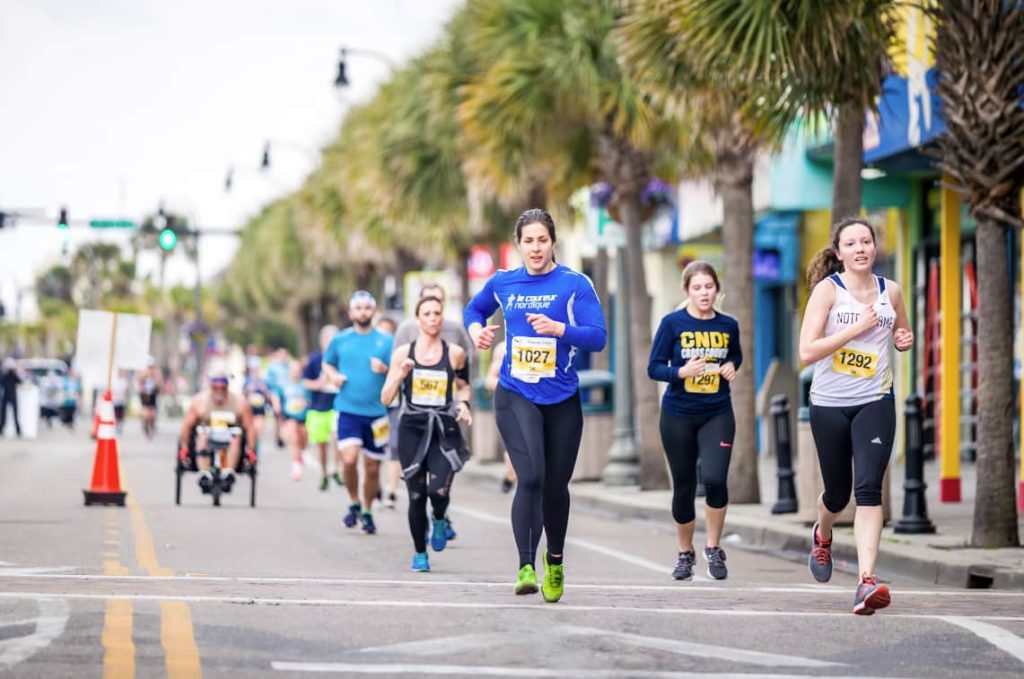
Step 3: Secure sponsorship for your walkathon, bikeathon, or runathon
As soon as you’ve finalized a date, time, and place, your organization should begin to look for sponsorships.
Nonprofit sponsorships involve partnering with a business or individual with means to support an event—through monetary contributions or by donating major goods and services—and can be crucial for hosting a successful event, whether both in-person or virtual.
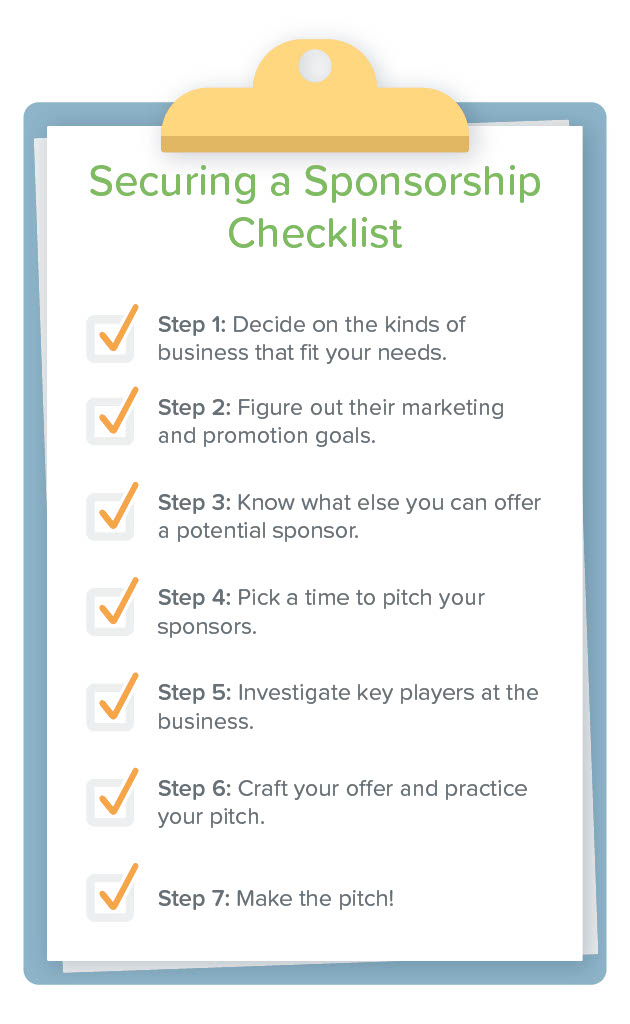
In exchange, sponsors get prime advertising real estate on T-shirts, posters, and other promotional materials.
It’s a win-win situation for all parties involved.
Because they’re so critical for fundraising events like walkathons, we’re going to go step-by-step through the process of securing a sponsor:
1: Decide on the kinds of businesses that fit your needs
Deciding on the kinds of businesses that fit your needs is arguably the hardest step of the process.
Start by looking into local businesses in your area. Try to find places that have a history of philanthropy.
That being said, you don’t want to waste any efforts on companies that are spreading themselves too thin.
Find businesses that want to help a good cause but aren’t committed to too many charities already. Businesses with similar missions to yours should also be top candidates! Talk to your staff members and volunteers about any mutual connections with local businesses to find your organization the best opportunities for potential sponsorships.
2: Figure out their marketing and promotion goals
Sponsorships aren’t totally free. They come at a cost to your organization.
Luckily, that cost is usually just promotion-related.
In order to gauge the sort of exchange you’ll need to make, it’s important to figure out prospective sponsors’ marketing and promotion objectives.
When you’re contacting potential sponsors, be sure to ask your points of contact about their marketing goals.
For example, what audience are they looking to reach? What kind of message are they trying to send about their company?
These types of questions will help you assess the goals and objectives that your prospective sponsors have.
3: Know what else you can offer a potential sponsor
As soon as you know what your prospective sponsors’ marketing and promotion goals are, you can begin to figure out what you can offer them.
Do you have members that are a part of their key audience? Are you going to have a wide reach when it comes to social media? If the event is virtual, what online platforms will you be depending on?
Once you’ve landed on a set of benefits you can offer a sponsor, pick a time to make your pitch.
4: Pick a time to pitch your sponsors
Scheduling can be tricky for a busy nonprofit. You’re planning an event, running an organization, and balancing what feels like a thousand plates at a time.
Your potential sponsors are also incredibly busy running a business!
You want to give your organization time to get all of your ducks in a row.
That’s why it’s crucial to schedule your pitch at least a couple of months in advance of when you’d actually need funding.
5: Investigate the key players at the business
While you’re trying to figure out the best time to have a meeting, it’s also important to assess who the key players at the business are.
For this, it helps to have someone who can tell you who has the most authority to sign off on a sponsorship and who would be the most likely to do so.
6: Craft your offer and practice your pitch
After you’ve figured out when and with whom you’ll be speaking, it’s time to start crafting your offer and practicing your pitch.
Keep your pitch short, sweet, and to the point. Emphasize what your sponsor will be getting out of this deal, and don’t be shy about expressing the needs of your organization.
Let your potential sponsors get a sense of the good that their sponsorship could help achieve by clearly explaining your mission and giving an impactful example of your organization’s success.
Of course, don’t forget to practice. A smooth presentation comes with persistent preparation.
7: Make the pitch!
All of your research and hard work has led up to this point: making the pitch!
On the day of the meeting, ensure that you have everything you need.
Have copies on hand of any documents you’d like to share with your prospective sponsors.
Run through your PowerPoint or notecards one last time to work out any final glitches or stumbling points.
Most importantly, be confident!
The point is: There are several steps involved with securing a sponsorship. Make sure you find businesses that suit your needs. Offer them something in exchange and craft a well-thought-out pitch.
Step 4: File the necessary event paperwork
Any good fundraising event checklist will remind you to fill out any necessary paperwork that might pertain to your event.
For some events, that means looking into health code regulations, making sure that you have the proper permits, and following relevant guidelines in order to sell or serve food.
As far as events like bikeathons, runathons, and walkathons go, research not only the kind of paperwork your organization will need to fill out and file, but also the types of waivers and forms that participants may need to sign.
Since these events are possibly dangerous physical activities, you will almost certainly need to have all of your participants fill out and sign liability waivers.
You can never be too careful when it comes to hosting an event, even if it’s a virtual one. It’s better to err on the side of caution by drawing up waivers to release your organization of any liability in the event of injury or accident. Leading up to the event, send reminders to participants to submit their waivers to avoid any last-minute panic the day of the event.
Most waivers are:
- Straightforward
- Less than a page
- Easy to find online
- Simple to copy
In addition to waivers, your organization should also look into what local authorities, like the police and fire department, require of an event like a bikeathon, runathon, or walkathon.
If you’re hosting your event on public property, you might have to fill out some liability paperwork or keep your event under a certain size.
It’s really up to the local authorities, so give them a call to sort everything out. You can even acquire their help in directing traffic around the event.
The point is: In order to keep everyone safe and happy at your walkathon, runathon, or bikeathon, your organization will need to distribute waivers to every participant and file any requisite forms with local authorities.
Step 5: Create registration and donation forms
Before you can get your event off the ground, you’ll have to create registration and donation forms.
A great event registration or donation form is typically:
- Fully customizable and personalized
- Mobile-responsive and mobile-friendly
- Shareable via email and social media
- Easy-to-use and uncluttered
- Consistently branded
When it comes to your event, your organization should have a unique registration and donation page— one that’s easily recognizable and easy-to-use.
Having an unbranded, cluttered, unresponsive registration or donation form could mean the difference between 20 people signing up and 2,000 people pledging.
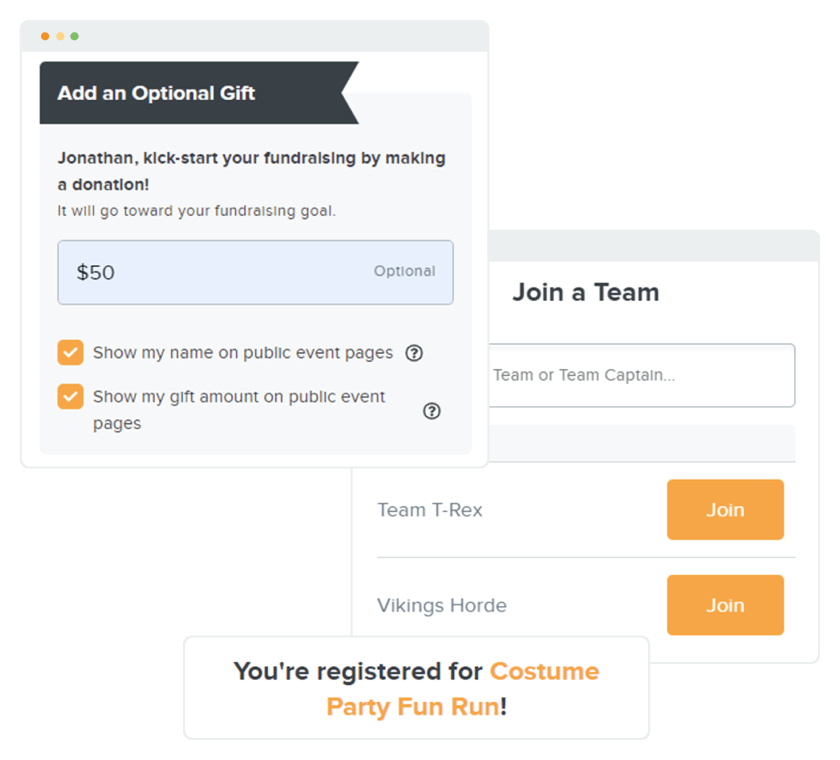
Some registration form tips include:
- Creating packages for families
- Offering tier goals for participants
- Having a donation option at registration
- Optimizing your forms for mobile use
The point is: Registration forms and donation pages are vital to any event fundraiser. Ensure that anyone can sign up and donate for your walkathon from anywhere, at any time by creating online and mobile registration and donation pages.

Step 6: Design t-Shirts for your walkathon, bikeathon, or runathon participants
Remember that fundraiser you participated in a few years ago? You probably still have the T-shirt you got for participating.
Sure, it may have a few holes in it now, and it’s almost definitely faded and shrunken a bit, but all of those signs of wear are really just signs of love.
You loved being a part of that event and making a difference. And you really loved having a badge of honor to show for it, proof that you were there and contributed to making the world a better place.
As you’re planning your own event, keep this in mind. Whether your walkathon, bikeathon, or runathon is in-person or virtual, providing a fun memento will make the experience all the more special.
To get started, find an apparel company or website that fits your budget and needs.
Once you’ve found a site or shop that works for you, decide on the types of apparel you want to offer participants and consider the type of fabrics that will be best to use.
If you’re hosting a bikeathon or walkathon in the winter, you might consider choosing a long-sleeved or sweatshirt option. Conversely, if you’re throwing a fundraiser in the middle of July, you’ll want to go for a cooler option, like a light-weight tee or athletic tank. You can also offer other apparel options such as bandanas or sweatbands.
With the type of clothing decided upon, the next step is designing it!

Your organization may want to highlight key sponsors on the back of the shirt, as per any agreements you may have made.
The front of the shirt is entirely up to you. Make sure that it communicates what your fundraiser is all about, while still being easy-on-the-eyes!
The point is: Designing shirts for your walkathon, bikeathon, or runathon is an excellent way to help commemorate your fundraiser and give participants something to show off for years to come!
Step 7: Spread the Word About Your Fundraiser
With planning completed, it’s time to start promoting your event! One of the best ways to get the word out about your upcoming fundraiser is through your fundraising participants.
Peer-to-peer fundraising usually involves an organization enlisting the help of its supporters to spread the news about a fundraiser to their own personal and professional networks.

Your volunteer peer-to-peer participants will typically reach out to:
- Friends
- Family
- Coworkers
- Acquaintances
- Social media followers
In turn, those friends and family members may even extend invites to their own social network connections. Before you know it, you’ve set off a domino effect and your fundraising event has reached more people than you ever imagined.
Encourage participants to tell a personal story about participating. You can even offer media copy prompts for participants to use that include your event hashtag.
Of course, in addition to employing peer-to-peer fundraising, your organization should utilize other methods of raising awareness.
Methods such as:
- Taking out an ad in the local paper,
- Creating an event page on Facebook,
- Sending out an email blast to your contacts,
- Tweeting, Instagramming, and Snapchatting,
- Calling up local media to make a press release,
- And any other methods that have worked in the past!
Don’t limit yourself to just one tactic. Run the gamut from traditional to brand new ideas to see the best and broadest results.
The point is: Marketing a walkathon, bikeathon, or runathon is crucial for its ultimate success. Be sure that you’re diversifying your approach and exploring new options for promoting your event.
Step 8: Have volunteers show up early
On the day of the event, you want to have a plan in place for your volunteers. That way, everyone knows where they need to be, what they need to be doing, and when they need to be there. Create your plan ahead of time and review it with your volunteers to clear up any questions or conflicts.
For an in-person event, have your volunteers show up to the event location as early as you think is necessary. You might want to have certain types of volunteers show up at different times, depending on their duties.
For instance, those who are manning the registration table should show up at least 30 minutes to an hour early. Volunteers who are setting up the route with markers should ideally show up a couple of hours in advance to lay everything out.
That being said, you may also have volunteers whose sole job it is to help clean up or help with the celebration at the end.
For a virtual event, it’s a good idea to connect with your volunteers and staff members online before it officially starts.
Ensure that everyone is on the same page, knows their roles, and can troubleshoot any technical problems.
A final note about your volunteers: They’re passionate and dedicated to your cause. Be sure to express your gratitude for them appropriately.
The point is: It’s best to have your volunteers show up a couple of hours before the kick-off time, ensuring you’re fully prepared for anything.
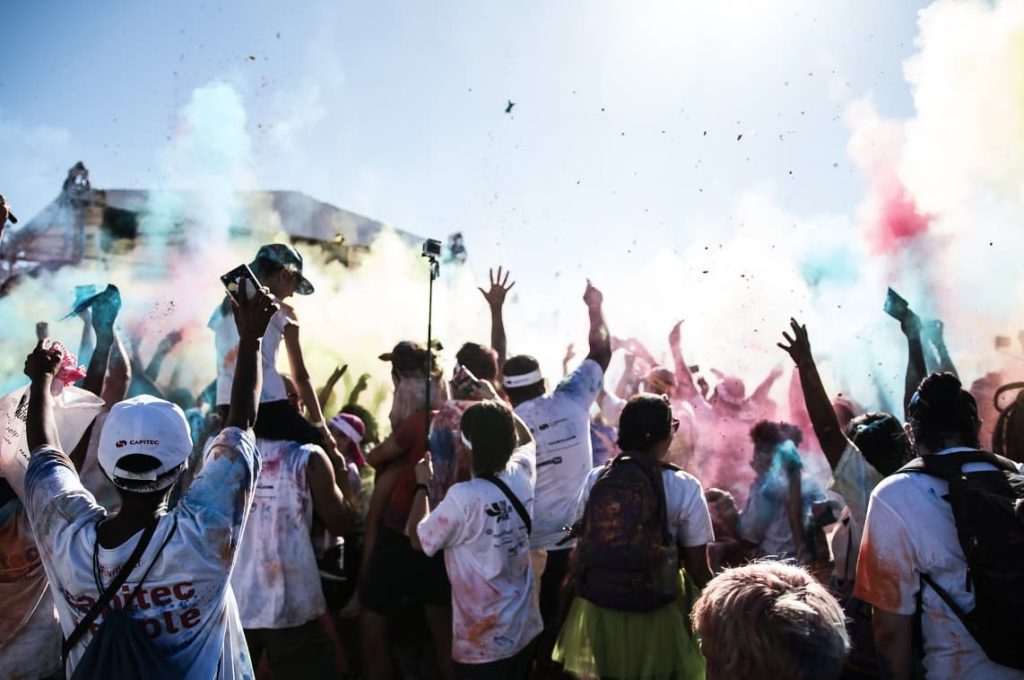
Step 9: Walk, bike, run, and have a great time!
You’ve worked long and hard to get to this point. It’s 100% okay to celebrate and enjoy the event!
In fact, it’s highly encouraged. When your participants see you enjoying yourself and getting into the event, they’re bound to feel more enthusiastic themselves.
Imagine this scenario. Dozens of attendees are showing up, whether in-person or through video online. They’re ready to go with their walking shoes, T-shirts, and bikes.
But because you’ve been planning and arranging and rearranging everything for so long, you’re no longer excited about the event. Even worse, your negative mood can rub off on excited attendees!
Luckily, this situation is entirely avoidable.
All it takes is stepping back from the walkathon for a moment and assessing the reasons you’re there to begin with. It was your passion for the cause that brought you to plan a fundraiser in the first place. Tap into that sentiment on the day of the walkathon, bikeathon, or runathon to renew your excitement.
In order to show this excitement through a virtual event, consider livestreaming your and your volunteers’ point of view and providing commentary on your participants’ progress. Share your fundraising thermometer on your website, livestream, and social media throughout the event. You can even put together a fun Spotify playlist that everyone listens to together!
Be sure to express your gratitude and excitement around your participants. Joy is contagious, after all.
The point is: The best way to ensure that your participants have a great time is to have a great time yourselves.
Step 10: Thank Your Participants
Speaking of gratitude and excitement, let’s take a moment to talk about thanking your walkathon participants.
The #1 rule when thanking event participants is to send your sincere gratitude within the first 48 hours following the walkathon, bikeathon, or runathon.
The earlier you send out your thank you notes, the more appreciated your participants will feel. These letters can also help keep you at the top of donors’ minds. It is also a good chance to ask for feedback from your participants about what they’d want to see for your next event.
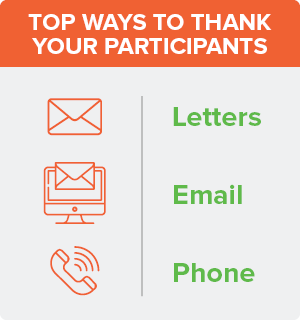
52% of people who have left a nonprofit, whether they quit donating, unsubscribed from emails, or stopped attending meetings, cited their reasoning as a lack of communication and gratitude.
Stay on top of your acknowledgments. As soon as the walkathon is over, start crafting your thank you letters.
If you’re worried that direct mail may be too slow, you can also shoot out a quick thank-you email blast.
Some fundraising software platforms even allow you to send out automatic acknowledgements after participants have registered, donated, or completed a pledge.
Phone calls are another great way to reach out personally to your dedicated walkers, bicyclists, and runners. However you choose to follow up, just make sure you do so in a timely manner.
The point is: Not only is it crucial to follow up and thank your event participants, it’s also extremely important to do so within the first 48 hours.
Final thoughts
Hosting a walkathon, bikeathon, or runathon can feel a little overwhelming, but take it all one step at a time, and you’ll get to the finish line in no time at all. Once your walkathon is over, celebrate your successes and then start planning your next peer-to-peer fundraiser as a pro.
Additional resources
Learn more about how to plan the best walkathon, bikeathon, or runathon fundraising event by exploring some of our own clients’ stories:
- Carmel Swim Club raised over $128,000 during their 10 Days of Courage, Perseverance, and Giving event which included
,not only peer-to-peer fundraising, but an auction and other fundraising methods as well. - Independence Center The 2022 Dancing with the St. Louis Stars peer-to-peer event grossed $736,000 for Independence Center. Fundraising teams and participants set up their own customizable fundraising pages, set goals, and tracked donations right on their page.
- Potter League raised $180,000 in 2020 through a combination of fundraising two events into one virtual event branded as ‘Yappy Hour’ and hosted a virtual ‘Heart & Sole Walk for Animals’.










